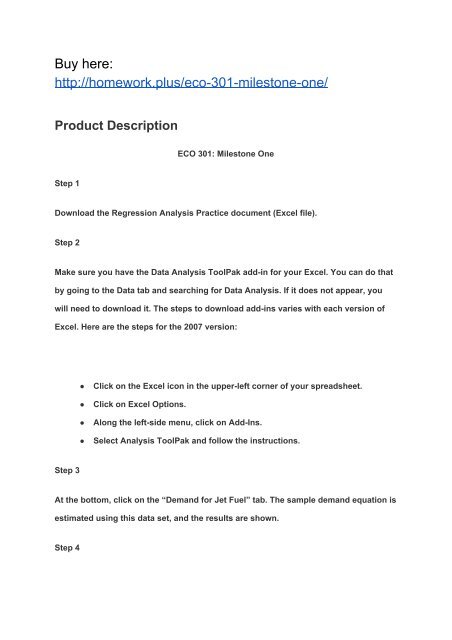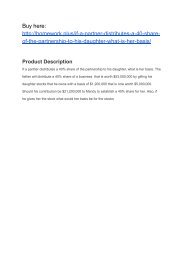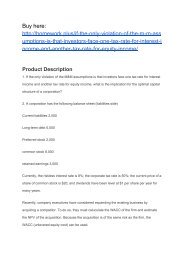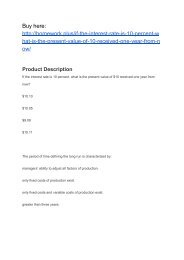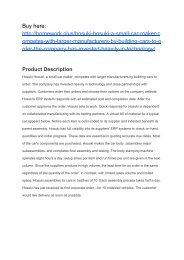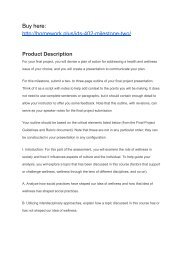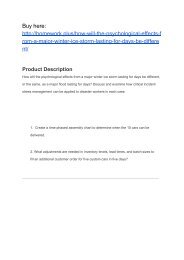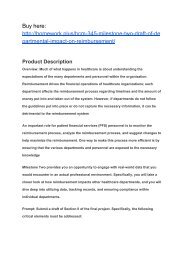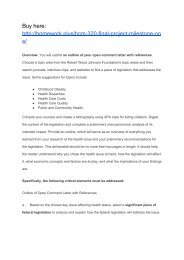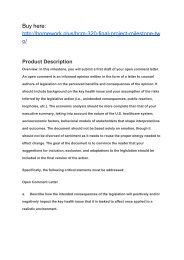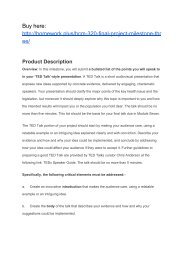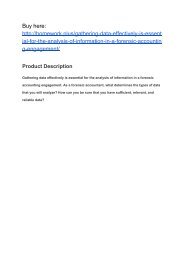ECO 301: Milestone One
ECO 301: Milestone One
ECO 301: Milestone One
You also want an ePaper? Increase the reach of your titles
YUMPU automatically turns print PDFs into web optimized ePapers that Google loves.
Buy here:<br />
http://homework.plus/eco-<strong>301</strong>-milestone-one/<br />
Product Description<br />
<strong>ECO</strong> <strong>301</strong>: <strong>Milestone</strong> <strong>One</strong><br />
Step 1<br />
Download the Regression Analysis Practice document (Excel file).<br />
Step 2<br />
Make sure you have the Data Analysis ToolPak add-in for your Excel. You can do that<br />
by going to the Data tab and searching for Data Analysis. If it does not appear, you<br />
will need to download it. The steps to download add-ins varies with each version of<br />
Excel. Here are the steps for the 2007 version:<br />
●<br />
●<br />
●<br />
●<br />
Click on the Excel icon in the upper-left corner of your spreadsheet.<br />
Click on Excel Options.<br />
Along the left-side menu, click on Add-Ins.<br />
Select Analysis ToolPak and follow the instructions.<br />
Step 3<br />
At the bottom, click on the “Demand for Jet Fuel” tab. The sample demand equation is<br />
estimated using this data set, and the results are shown.<br />
Step 4
Use the procedure described to estimate the demand for gasoline using the same<br />
steps identified in the example below. Sample answers are based on the “Demand for<br />
Jet Fuel” data.<br />
Evaluate adjusted R 2 .<br />
The adjusted R 2 is 0.778421. It indicates that approximately 78% of the variation in the<br />
demand for jet fuel across states is explained by the three independent<br />
variables—price, state GDP, and state population.<br />
Evaluate each of the independent variables using a t-test.<br />
Table 1 provides the results of the t-tests for each of the independent variables.<br />
Standa<br />
Coefficie<br />
rd<br />
P-Valu<br />
nts<br />
Error<br />
T-Stat<br />
e<br />
45.286<br />
-0.4074<br />
0.6855<br />
Intercept -18.4498<br />
17<br />
1<br />
6<br />
2.7885<br />
0.0496<br />
0.9606<br />
Price 0.138429<br />
82<br />
41<br />
19
0.0391<br />
4.3426<br />
7.45E-0<br />
GDP 0.170079<br />
65<br />
46<br />
5<br />
Populati<br />
0.0017<br />
2.9480<br />
0.0049<br />
on 0.005281<br />
91<br />
36<br />
67<br />
Table 1: T-Test Analysis<br />
To assist use the Student t-Value Calculator:<br />
http://www.danielsoper.com/statcalc3/calc.aspx?id=10<br />
The degrees of freedom are 47, and the probability is 0.05. The critical value is<br />
approximately 2. If the absolute value of the t-statistic is greater than 2, the null<br />
hypothesis can be rejected. The P-value results can be used to determine whether to<br />
reject each of the following hypotheses.<br />
Using the null hypothesis that each of the estimated coefficients is not significantly<br />
different from zero, and a 5% probably level (or a 5% probability of obtaining the test<br />
statistic as large or larger as the one obtained if the true value is in fact zero), the<br />
coefficients for GDP and Population are significant (reject the null hypothesis that the<br />
true values are 0), while coefficients for the intercept and price are not significant (do<br />
not reject the null hypothesis that the true values of the coefficients are zero).<br />
Price:
(a) H 0<br />
: βp = 0; H A<br />
; βp ¹ 0 Do not reject at the 5% level (P-value<br />
> 0.05)<br />
GDP:<br />
(b) H 0<br />
: βgdp = 0; H A<br />
; βgdp ¹ 0 Reject at the 5% level (P-value < 0.05)<br />
POP:<br />
(c) H 0<br />
: βpop = 0; H A<br />
; βpop ¹ 0 Reject at the 5% level (P-value < 0.05)<br />
Perform an f-test.<br />
H 0<br />
: βp = βgdp = βpop = 0;<br />
H A<br />
: at least one β is not equal to zero<br />
below.<br />
Use the analysis of variance (ANOVA) information given in the table<br />
ANOVA
Significa<br />
df SS MS F<br />
nce F<br />
Regressi<br />
368163<br />
122721<br />
59.551<br />
4.83988E-<br />
on 3<br />
.7<br />
.2<br />
15<br />
16<br />
96856.<br />
2060.7<br />
Residual 47<br />
2<br />
7<br />
465019<br />
Total 50<br />
.9<br />
Table 2: F-Test Analysis<br />
F = 59.5515<br />
Critical value<br />
Critical F-Value Calculator:<br />
http://www.danielsoper.com/statcalc3/calc.aspx?id=4
F(3,47) = 2.80235519<br />
Since the 59.5515 > 4.00, reject the null hypothesis. At least one of the β’s is not equal<br />
to zero. You can also use the “Significance of F” information, which indicates that the<br />
critical value would need to be essentially zero to not reject the null hypothesis.<br />
Step 5<br />
Submit your regression results and answers to the questions given using the<br />
Assignment link.


